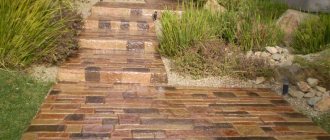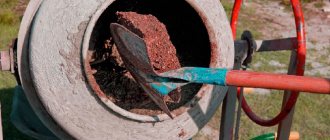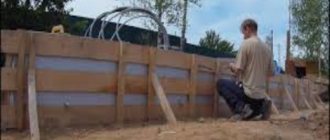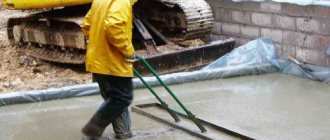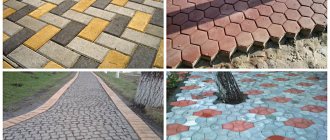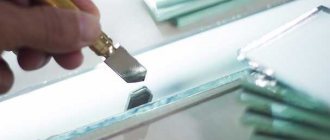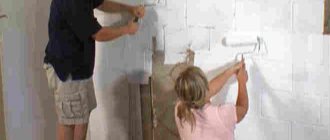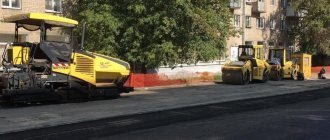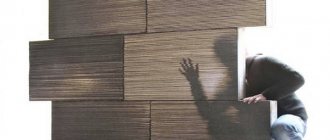Principle of operation
The definition of “dry” in the name of the technology is conditional. The technology involves feeding the dry mixture into the mixer nozzle, where water is supplied. Mixing occurs and the solution flies out of the nozzle under a pressure of 0.4...0.5 MPa. The jet speed reaches 170 m/s. Such values are achievable thanks to the dry mixture, which is lighter without water and is easily transferred by compressed air from a high-pressure chamber with a mixing and dosing device. The dispenser is made in the form of a revolving drum with an electric drive, which captures part of the mixture and transfers it to the compressed air supply zone (high pressure) and through a hose to the nozzle.
The main problem is the balance between the amount of water and the mixture (approximately 1:4). This is achieved by stable water pressure, known dry density of the mixture and adjustable compressed air pressure from the compressor. If there is a lack of water, the hydration process of cement may slow down, and if there is too much water, the solution becomes liquid and flows down the wall or from the ceiling. The operator of the installation for “dry” spraying of concrete mixture must undergo training and internship with a more experienced specialist.
Shotcrete equipment is supplied complete with:
- mixer hopper;
- dispenser and mixer drive;
- air compressor;
- hoses with a nominal bore sufficient for vertical and horizontal supply;
- mixer (nozzle).
The elements can be placed on one frame (capacity 4...20 m3/h) and separately - a dispenser and a compressor.
This is interesting: How long does concrete dry indoors and outdoors?
Types of process
Shotcreting with concrete can be carried out using two main technologies - wet and dry methods. The choice of a specific method is carried out taking into account the availability of an installation of the required type, the assigned tasks, the conditions for preparing the mixture, etc.
Dry concreting
The technology is based on the supply of water and dry cement mixture from different hoses. Both components are supplied under pressure with compressed air, which comes from compressors, and then mixed in a special sprayer. Next, the mixture is fed from the nozzle at a speed of 170 m/s on average.
Advantages of dry shotcrete:
The material is obtained with increased strength and density characteristics. The mixture can be supplied over long distances, which significantly speeds up the work process and increases maneuverability. Maximum level of adhesion.
Possibility of applying the mixture in a layer of up to 6 centimeters. Reduced cost of work due to reduced labor intensity and productivity. Possibility to turn on/off the installation at any time. Easy to operate and clean the installation. There is no need to prime the surface being treated. Higher mixture consumption due to rebound.
Among the disadvantages of the method, it is worth mentioning such as the need for the master to have shotcrete experience, the elimination of any errors in the process of mixing components, difficulty in working with dry material, increased contamination and dustiness of the work site. After applying the mixture, the concrete surface must be finished.
Wet method
When using this technology, the solution, ready for laying, enters the sprayer of the installation. The mixture is fed into the solution using a concrete pump or compressor. If a concrete pump is selected, the mixture flows into the nozzle under continuous pressure, ensuring that each layer is evenly distributed. But a pneumatic compressor pumps the mixture in portions, so the consumption of concrete increases.
The main advantages of the wet method:
The mixture is supplied to the sprayer ready-made, which increases the uniformity and high-quality coating of shotcrete of any design. Significant material savings, reduced waste due to low rebound. Possibility of finishing immediately after completing the last coat. The solution that does not get on the surface of the monolith can be used for other work. The mixture is sprayed at a minimum distance to the surface, so this shotcrete method can be used to carry out work in enclosed spaces. Absence of significant dust in the room or area. There is no need for mandatory additional processing of the concrete layer (grouting is sufficient).
Among the disadvantages, the following are mainly noted: the layer can be applied with a maximum thickness of 3 centimeters, the feed speed is low (up to 100 m/s), spraying takes a long time, the installation is difficult to clean after completion of the work, there is no possibility to maneuver due to short hoses for supplying the mixture, the lack of stop work (long downtime provokes hardening of the mixture and failure of equipment).
Currently reading: Types of floor screeds and methods for making them
Surface preparation and spraying
The surface for “dry” shotcrete does not require special preparation in the form of priming. It is enough to remove dirt by sandblasting and fasten the reinforcement in increments of 100 mm. The fittings must have an anti-corrosion coating, because The spraying thickness at a time is up to 6 mm. If additives accelerating the setting of cement are not used, then the next layer is sprayed after 2...4 hours, depending on humidity and air temperature. With mixtures with additives, work can be continued after 20...40 minutes.
The surface should be covered completely with an overlap of 15...20 cm over the adjacent layer. The layer should be applied in a circular motion from a distance of up to 1 m at an angle of 90° to the surface. The high pressure of compressed air causes the mixture particles to impact and bounce off the concrete surface. The distance to the wall or ceiling is selected based on the condition of the smallest rebound. Rebound mortar should be removed before it cures. After spraying the last layer, the surface should be smoothed with metal trowels, because the surface after spraying has a rough appearance. A sprayed wall or ceiling should be moistened with water for a week.
The work is carried out by a team of at least 2 people. Workers must have a full set of personal protective equipment, which is provided for by safety rules for working in dusty interior spaces.
Shotcrete
MasterRoc STS 115
Dry mixture for the construction of concrete pavements using shotcrete technology
Shotcrete
Mapegrout Gunite 300 AF
Ready-made, one-component fiber-reinforced cement mortar with accelerated hardening for concrete repair using dry shotcrete.
Shotcrete
Sika Gunit 03 Normal
Ready-mix for dry shotcrete
Shotcrete
Mapegrout Gunite
One-component ready-mix without accelerators on a cement base for concrete repair using dry or wet shotcrete
DIY shotcrete
Required equipment and tools for dry shotcrete:
- Compressor unit with a tank using purified air
- Cement gun with storage bins for dry mixes, inlet and outlet fittings
- Storage tank for water, having a fitting for taking compressed air from the compressor unit and an outlet pipe
- Nozzle for mixing and applying mortar mixture to the surface to be treated
Equipment for wet shotcrete:
- Concrete mixer for preparing mortar mixture
- Installation for mechanized sifting of aggregate (vibrating sieves with 8 mm mesh) Only certain fractions of aggregate are used for mixing (up to 8 mm or according to the technical characteristics of the installation)
- Solution pump
- Chamber for mixing the finished solution and purified compressed air from the compressor unit
- Nozzle for applying mortar mixture to a concrete structure
Shotcrete installations can be purchased as individual devices and units, or as a set. A ready-made kit allows you to do the work yourself. To prepare solutions, it is possible to either use ready-made dry mixtures, which saves time and gives good quality, but at the same time is very expensive, or dosage the mixtures yourself by weighing.
Sometimes plaster hopper buckets are used for shotcrete. A hopper bucket is a cone-shaped metal container with a pipe through which it is connected to a high-power compressor. A pressure of 4-6 atm is required for operation. The lower part of the hopper bucket has a hole for the nozzle. The advantage is that it is possible to change nozzles of different diameters, this allows you to apply layers of different thicknesses, followed by leveling. Excess solution can be reused.
Preparing for shotcrete
- For high-quality shotcrete, it is necessary to ensure adhesion of the solution to the surface being treated.
- There should be no oil or petroleum products stains on the concreting surface. All contaminated areas are cut down or sandblasted
- Deep narrow cracks are pre-sealed with mortar, since their proper sealing is questionable. There should be no voids under the shotcrete.
- All protruding edges, edges, and shells up to 50 mm are cut off, the bevel angle is made at least 45 degrees. If there are sinkholes on the surface deeper than 50 mm and more than 100 mm in diameter, they are sealed with a repair mixture or special solutions, having previously beveled the edges at an angle of at least 45 degrees
- If the surface has been treated with iron plating, it is roughened by sandblasting
- Reinforcing mesh and flat reinforcement frames are cleaned of dirt. Oil, dirt, and flaking rust on the surface of the reinforcement are not allowed, as they can significantly reduce adhesion. Both sandblasting and acid blasting are used
- The entire surface is cleaned, dirt, debris, and old mortar are removed
- The surface is thoroughly moistened with plenty of water.
With the wet shotcrete method, a portion of the prepared solution should be produced in two hours, while the solution has the greatest mobility and activity. Early setting of the solution reduces the quality of work.
The use of mixtures using different binders and with various additives makes it possible to create frost-resistant, non-flammable, waterproof, and chemically resistant coatings. For use on private construction sites, shotcrete concrete is in demand both for the reconstruction and strengthening of load-bearing structures of foundations, walls and vaults, and for finishing walls and ceilings. Shotcrete technology provides not only a reinforcing layer, but also the ability to give the treated surface an aesthetic appearance along with increased strength and wear resistance.
Cost of dry spraying work
Shotcrete is comparable to polyurethane spraying. The wet method is used for large objects, because... you need to use a mixer or mortar unit, concrete pump, which is unprofitable for small objects. The “dry” method also requires special equipment, but its range is more extensive and allows you to select a shotcrete installation based on power or productivity. This method is more economical in terms of solution consumption, but the mixtures themselves with special properties cost money.
The cost will consist of:
- Cost per hour of equipment operation.
- Cost of the mixture.
- Difficulties of work (areas with complex profiles, reinforcement, work in cramped conditions).
- The distance of the object from the base.
- Time of year, because During the cold season, the duration of work on site increases.
Share with friends
What is shotcrete
The process is a method of applying concrete and cementitious coatings to any type of surface at any angle. Spraying shotcrete involves applying the solution with strong pressure from a hose with a special sprayer under the influence of compressed air. As a result, concrete lies in a dense layer on the surface, filling cracks, irregularities and pores. This significantly distinguishes the method from other application methods, since the surface coated in this way is highly durable, frost-resistant and is not exposed to water.
This method of applying concrete makes it possible to erect load-bearing structures in a relatively short time, even without the use of formwork. The mixture applied in this way dries quickly and allows structures to be strengthened with additional layers at high speed. This creates a structure of optimal thickness without excessive effort. This explains the increased interest in this method of concrete application during intensive urban construction.
The shotcrete solution is a mixture of cement, water, sand, special aggregates, binders and modifying additives.
Experienced builders do not recommend using crushed components with sharp edges for the mixture. There is a high potential for equipment damage or worker injury from this component bouncing off the spray surface. The composition of the mixture is determined individually depending on the type of construction and type of work.
Spraying concrete has a wide range of applications and is used in both industrial and civil construction.
This technology is often used:
- In the construction of tunnels and in the mining industry for securing rocks.
- During the construction of foundation pits, basements, supporting devices for bridges, road and railway interchanges.
- When repairing or reconstructing concrete and reinforced concrete structures. They can be strengthened or damaged concrete can be replaced.
- In various industrial processes involving the use of high temperature, shotcrete acts as a fire-resistant and wear-resistant material.
- For sealing and heat resistance of the building.
- For the construction of water supply systems, such as reservoirs or a water tower.
- For strengthening soil under unstable or grounded structures.
This method is used at home when carrying out repair work, but this requires a compressor and a special bucket for laying the solution. The process is performed only a short distance from the surface.
Due to the high adhesive properties of the solution used for shotcrete, this method allows you to apply ideal layers of concrete mixture to any surface, even without preliminary preparation. But the methods of applying the solution differ in composition, method of preparation, as well as the equipment used for shotcrete.
For example, depending on the granularity of the filler used in the shotcrete solution, 2 classes of mixtures are distinguished. In the first class, fillers up to 10 mm are used, and in the second - up to 25 mm. The second type of mixture is called syringe concrete. It allows you not to use formwork during construction work.
Depending on the conditions of construction work and the technology used, there are 2 main methods of using shotcrete - wet and dry.
Dry method
This type of shotcrete was developed at the beginning of the 20th century. It is characterized by the fact that a dry mixture of various fillers and cement is supplied to the sprayer without adding water. Mixing is done directly in the sprayer, where a mixture of the required consistency is formed.
Water is supplied separately with strong pressure through another hose. This method of applying concrete allows you to use the equipment in any conditions without having to regularly clean it. This method has both disadvantages and advantages. A person who is going to use this method in his work should be aware of these factors.
There are some disadvantages:
- The mixture for dry shotcrete must be carefully checked for the correct ratio of components, since a violation will lead to a decrease in the strength of the structure.
- The spraying working area becomes very dirty during this process.
- Dry mixture components may bounce off the surface and cause injury to workers.
- This type of shotcrete requires experience in the field of construction.
Advantages of dry shotcrete:
- The surface does not need a primer.
- This method is quite easy to use, and the equipment for it does not require additional maintenance, therefore it is considered wear-resistant.
- The spray distance can be varied.
- Water consumption can be controlled.
- The thickness of the applied layer can reach 6 cm, which increases labor productivity.
- Layers applied in this way have a high level of adhesion.
Wet method
The wet method of shotcrete arose much later than the dry method. This is due to the gradual development of science in the field of chemistry, thanks to which new components have been developed to create a durable concrete mixture for spraying.
This method involves using a ready-made solution by feeding it into a special concrete pump, and from there through a hose into a sprayer (nozzle). The mixture flows in a continuous stream, which is supported by a stream of air from another hose. Thanks to air pressure, the mixture is broken and delivered to the application surface.
When shotcreting, the number and frequency of bounces is reduced, which reduces the traumatic nature of the process.
This shotcrete method also has its pros and cons.
The following advantages are highlighted:
- To apply the wet mixture, the qualifications of the worker are not particularly important, since working with it is quite easy.
- High degree of homogeneity of the concrete mixture.
- The construction area is not subject to heavy dust.
- This method can be used in enclosed spaces.
- Shotcrete applied using this method does not require additional processing; it is enough to wipe the surface.
- Relatively waste-free, since the remaining mixture can be used for other types of work.
The disadvantages include the following factors:
- The concrete mixture sets already in the hose, so even short-term interruptions in application are eliminated.
- The use of short supply hoses, which causes some inconvenience in maneuvering equipment on the construction site.
- Small thickness of the applied layer of the mixture.
- Quite a long time to apply the mixture.
- Difficulties encountered when cleaning shotcrete equipment.
- Expensive mixtures due to the introduction of viscosity additives into it.
- Inability to use equipment over large areas.
What concrete shotcrete method do you use?
This is interesting: Liquid waterproofing for concrete: how to choose, popular brands
Types of shotcrete
Due to the high adhesive properties of the solution used for shotcrete, this method allows you to apply ideal layers of concrete mixture to any surface, even without preliminary preparation. But the methods of applying the solution differ in composition, method of preparation, as well as the equipment used for shotcrete.
For example, depending on the granularity of the filler used in the shotcrete solution, 2 classes of mixtures are distinguished. In the first class, fillers up to 10 mm are used, and in the second - up to 25 mm. The second type of mixture is called syringe concrete. It allows you not to use formwork during construction work.
Depending on the conditions of construction work and the technology used, there are 2 main methods of using shotcrete - wet and dry.
Dry method
This type of shotcrete was developed at the beginning of the 20th century. It is characterized by the fact that a dry mixture of various fillers and cement is supplied to the sprayer without adding water. Mixing is done directly in the sprayer, where a mixture of the required consistency is formed.
Water is supplied separately with strong pressure through another hose. This method of applying concrete allows you to use the equipment in any conditions without having to regularly clean it. This method has both disadvantages and advantages. A person who is going to use this method in his work should be aware of these factors.
There are some disadvantages:
- The mixture for dry shotcrete must be carefully checked for the correct ratio of components, since a violation will lead to a decrease in the strength of the structure.
- The spraying working area becomes very dirty during this process.
- Dry mixture components may bounce off the surface and cause injury to workers.
- This type of shotcrete requires experience in the field of construction.
Advantages of dry shotcrete:
- The surface does not need a primer.
- This method is quite easy to use, and the equipment for it does not require additional maintenance, therefore it is considered wear-resistant.
- The spray distance can be varied.
- Water consumption can be controlled.
- The thickness of the applied layer can reach 6 cm, which increases labor productivity.
- Layers applied in this way have a high level of adhesion.
Wet method
The wet method of shotcrete arose much later than the dry method. This is due to the gradual development of science in the field of chemistry, thanks to which new components have been developed to create a durable concrete mixture for spraying.
This method involves using a ready-made solution by feeding it into a special concrete pump, and from there through a hose into a sprayer (nozzle). The mixture flows in a continuous stream, which is supported by a stream of air from another hose. Thanks to air pressure, the mixture is broken and delivered to the application surface.
When shotcreting, the number and frequency of bounces is reduced, which reduces the traumatic nature of the process.
This shotcrete method also has its pros and cons.
The following advantages are highlighted:
- To apply the wet mixture, the qualifications of the worker are not particularly important, since working with it is quite easy.
- High degree of homogeneity of the concrete mixture.
- The construction area is not subject to heavy dust.
- This method can be used in enclosed spaces.
- Shotcrete applied using this method does not require additional processing; it is enough to wipe the surface.
- Relatively waste-free, since the remaining mixture can be used for other types of work.
The disadvantages include the following factors:
- The concrete mixture sets already in the hose, so even short-term interruptions in application are eliminated.
- The use of short supply hoses, which causes some inconvenience in maneuvering equipment on the construction site.
- Small thickness of the applied layer of the mixture.
- Quite a long time to apply the mixture.
- Difficulties encountered when cleaning shotcrete equipment.
- Expensive mixtures due to the introduction of viscosity additives into it.
- Inability to use equipment over large areas.
What concrete shotcrete method do you use?
Dry
Wet
Shotcrete foundation (preparation, preparation of mortar, laying)
With a change in the purpose of buildings and structures, as well as with the restoration of historical monuments, the need arises to strengthen the load-bearing capacity of the foundation, restore or create a new reinforcement frame, and eliminate mechanical damage caused by time and weather. Shotcrete technology successfully copes with these problems, forming a monolithic concrete coating of increased strength, moisture resistance and frost resistance up to 30 mm thick. A concrete solution under pressure fills cavities, cracks and uneven areas in the foundation.
The step-by-step implementation of strengthening the foundation using shotcrete includes the following steps:
- analysis of the condition of the foundation, mechanical cleaning of cracks, cavities, removal of delamination from previous repairs;
- restoration of old or creation of new reinforcement structure;
- thoroughly blowing the surface with compressed air to remove any remaining dirt and dust;
- installation of beacons to determine the thickness of the layer;
- for better adhesion, the surface must be well moistened;
- preparation of the required mixture composition for the dry method by a trained specialist; for the wet version, there are many ready-made mixtures for specific tasks;
- shotcrete mortar using dry or wet method;
- finishing work with coating with a film-forming composition.
This method of strengthening the foundation will restore the damaged foundation for a long time.
Shotcrete allows you to solve many problems in the construction industry and, despite the significant costs of equipment, provides a good economic effect when using it.
Information sources:
- STO 16216892-001-2008 “Methodological recommendations for the use of shotcrete concrete TU 5745-001-16216892-06 in design work for the construction of new and reconstruction of existing road transport and communication structures.”
- Requirements TU 5745-001-16216892-06 “Shotcrete concrete” for quality control of shotcrete concrete.
- Technical characteristics and operating instructions for shotcrete installations.
- Bio
- Latest Posts
About me : Generalist specialist. Experience as an editor and author of articles as a journalist for more than 12 years. He graduated from the Faculty of Philology of the Belarusian State University (Department of Russian Language and Literature) and received a diploma in the specialty “Philology. Teacher of Russian language and literature."
- Concrete retarders - 08/28/2020
- Concrete hardening accelerators - 08/23/2020
- Compressive strength of concrete - 08/18/2020
Installation
For shotcrete, special installations are used, usually consisting of the following elements: a concrete pump or compressor, a concrete mixer, hoses, a hose, a sprayer and nozzles. Depending on the shotcrete method, installations are designed for dry and wet concrete supply.
The dry shotcrete installation provides the supply of water and dry cement mixture through various pipelines. The machine delivers the composition over long distances with high productivity, does not require washing, and allows you to create a thick layer. Installation kit: unit, compressor, water tank, nozzles and high-pressure hoses.
Installations for wet shotcrete supply ready-made cement mortar from a concrete pump through a hose into the nozzles. Material consumption is reduced, which is important for indoor use. The thickness of the coating (maximum value) is 2 times less compared to the dry method.
There is a fairly large selection of domestic and foreign-made equipment on the market. Installations from the German company PFT that work using the wet method are popular. The standard equipment of the G4 and G5 series units includes: an auxiliary air blower, a mixing gun nozzle, and a control panel.
If necessary, the installation can be rented - in this case, the costs will be much lower. The rent is determined individually and varies in the range of 990-3500 rubles per day. The cost depends on the model, rental time, deposit amount, etc.
Shotcrete installations for dry application produced by Alpservice JSC (Ukraine) have proven themselves well in the market. They are often used to restore various types of hydraulic structures, strengthen foundations and tunnels, and repair work. The installation delivers building material over a distance of up to 80 meters.
When choosing a shotcrete installation, you need to pay attention to the method of performing the work, volumes, hose length, power, pressure and other features.
Existing varieties
Shotcrete-type concreting is carried out using two generally accepted methods. There is a wet and dry technological process, it all depends on the method of supplying the working solution to the prepared surface. Which method to use in a particular case will be determined by the assigned tasks, the equipment used for the work, the conditions for creating the solution and its subsequent delivery.
The principle of the dry technique
The entire technological process consists of supplying a granular homogeneous mixture and water through different hoses under a certain pressure. Under the action of compressed air, which is provided by a compressor, these ingredients are mixed in a common sprayer. This procedure has a number of positive aspects:
- increased level of adhesion;
- ensuring high strength and density of the created fabric;
- the ability to create a protective layer up to 60 mm thick;
- supplying the mixture over a long distance, resulting in reduced working time and increased maneuverability;
- The equipment is switched off and on again during operation if necessary.
Among the disadvantages, increased contamination of the area where shotcrete is performed is noted. Upon completion of applying the cement mortar under pressure, the canvas is finished. The supply of dry mixture from the hose is regulated by an experienced person, otherwise the quality of the finished product may suffer.
Equipment
Concrete shotcrete is applied to the surface to be treated in two ways - dry and wet. To perform this or that method, appropriate equipment is used. To spray concrete using the dry method, you need the following:
- a compressor equipped with a tank used to purify air from impurities of mechanical origin;
- a cement gun, its components are storage bins for the dry mixture, and inlet and outlet fittings;
- a tank or storage container for filling with water, with a fitting for the intake of air coming from the compressor, and an outlet for a mixture of gas and water;
- a nozzle in which mixing of flows occurs, carrying out shotcrete of the mixture.
To perform wet shotcrete the following equipment is used:
- concrete mixer or BRU for supplying concrete mixture in a continuous flow in a uniform layer;
- a vibrating sieve, which is used to remove large debris;
- pump supplying solution;
- a chamber mixing the liquid additive and compressed air, which has been pre-cleaned from impurities in the compressor;
- a nozzle that delivers shotcrete to the desired surface.
Equipment for spraying concrete can be manufactured in two versions - individual devices and units, and a complex of installations. With their help, you can apply wet concrete coating yourself at home. For self-repair using shotcrete, ready-mixed concrete is used.
Types of technologies
Dry shotcrete is performed using special equipment. Mixing of dry concrete mixture and water occurs directly in the nozzle. The liquid is supplied under high pressure, this helps to obtain a finished solution at the outlet of the unit. This technology has many advantages:
• high feed speed of the finished mixture;
• creating a layer up to 6 cm;
• the ability to supply concrete over long distances;
• low water consumption;
• obtaining a solution with a high degree of adhesion.
Carrying out concrete work using shotcrete method
Applying shotcrete concrete
Before shotcreting, it is necessary to inspect the base and ensure proper surface preparation.
To obtain a high-quality shotcrete coating, it is necessary to strictly follow the work technology and carefully study the instructions for using the shotcrete installation:
- Shotcrete mode (method);
- recommended distance from the nozzle to the surface to be treated;
- recommended distance from the installation to the work site;
- optimal pressure in the hoses;
- required water-cement ratio of the solution;
All these necessary conditions depend on the technical characteristics of the selected machine.
Shotcrete technology consists of three mandatory stages:
- Surface preparation.
- Preparation of shotcrete concrete.
- Applying the mixture to the base.
Preparing the base
Surface treatment by sandblasting machine
Surface preparation for shotcrete must be carried out in compliance with the following rules:
- Clean the surface from dirt, oil stains, old paint residues, etc.
- Clean exposed fittings from rust.
- Remove loose parts of the concrete mass.
- Smooth surfaces must be treated with metal brushes or a sandblasting machine to roughen the base.
Sandblasting unit
- Surfaces with potholes up to 5 cm deep should be prepared with base notches. Deeper defects should be cleaned and, after washing and blowing with compressed air, sealed with a cement mortar of 1:3 composition.
- Before applying the gunite mixture, blow off the surface treated in this way and rinse it with water. Washing is carried out with a cement gun under a pressure of 0.2–0.3 MPa.
Preparation of shotcrete solution
When producing shotcrete mixture, you can use any modern forced-action mixers.
Ready-made dry shotcrete mixture
Ready-made dry mixtures for preparing shotcrete concrete solutions are available for purchase at a hardware store. If you are not satisfied with the price, you can cook it yourself.
Shotcrete installations can be purchased as a set or as separate units.
Making shotcrete with your own hands
Instructions for preparing and applying shotcrete mixtures:
- To cover bases subject to mechanical impact loads with shotcrete, the composition should have a ratio of 1:3, and for surfaces exposed only to atmospheric influences - a ratio of 1:4.
- The finished dry mixture, before mixing with water, must be sifted through a construction sieve with a mesh size of no more than 8 mm.
Construction sieve
- The necessary modifying additives are introduced into the solution according to the instructions specified for them, located on the back of the package.
- Shotcrete must be carried out at an ambient temperature of at least 5°C. At lower temperatures, it is recommended to add antifreeze additives to the mixture.
- With a correctly formulated and sufficiently moistened solution, the gunite mass coming out of the nozzle has an even, uniform color. If there is not enough water, dry streaks appear on the coating, and a large amount of dust accumulates near the gunite areas. Excessive water consumption, on the contrary, leads to the solution slipping and the formation of mortar “bags” on the gunite coating.
- Apply the gunite solution in layers. When applying the first layer, the tip should be located at a distance of 80–100 cm from the surface to be treated. The second and subsequent layers should be applied at a shorter distance, but not less than 50 cm.
Layer-by-layer laying of shotcrete mortar on the frame of the future structure
- Shotcrete is carried out in horizontal strips 1-1.5 m wide along the entire length of the surface.
- During operation, the nozzle should be moved evenly in a spiral, positioning it perpendicular to the surface being treated.
- The number of layers of shotcrete is determined by the design documentation. The minimum thickness of one coating layer is about 5–7 mm.
Tips: increasing the number of applied layers of the mixture improves the waterproof performance of the concrete coating, but at the same time, significantly increases the cost of the work performed.
- Each subsequent layer of solution (with hardening accelerators) should be applied no earlier than 20 minutes to 40 minutes in order to avoid damage to the structure of the previous layer under the influence of the jet.
- When using shotcrete mixtures without hardeners, the interval between applications should be 4 hours or more.
- When stopping work for more than 40 minutes and upon completion of work, the shotcrete installation and mortar hoses must be thoroughly rinsed with water and blown with compressed air, and the mixing chamber and nozzle of the unit must be disassembled, washed and dried.
Caring for freshly laid shotcrete concrete
Measures for the care of freshly laid shotcrete concrete pavement, depending on the composition of the mixture, must meet the following requirements:
- During hardening, shotcrete must be protected from drying out, chemical influences, mechanical damage and, during low temperatures, from freezing.
- Quick-hardening mixtures with special additives last for at least 6 hours, and when using additive-free solutions, for at least 3 days.
- The shotcrete coating is moistened with water until it reaches its design strength (70%). The humidification mode depends on the air temperature (see table).
Mode of moistening freshly laid shotcrete concrete
- In addition to moistening, the horizontal surfaces of the coating are covered with damp burlap or plastic film; vertical and ceiling structures are coated with film-forming compounds (ethylene varnish, etc.).
Shotcrete has significant advantages over other methods of concrete work due to the complete mechanization of the process: transportation of the mixture, supply and placement of the solution with simultaneous compaction.
Shotcrete Application Methods
Depending on the state of aggregation of the initial mixture, it is customary to distinguish between dry and wet shotcrete methods, the names of which correspond to the degree of moistening of the material before it is fed to the nozzle.
When dry shotcrete, the initial mixture is prepared in compliance with the following requirements:
1. Mixing is performed centrally or locally, depending on the distance between the mortar unit and the work site. It is recommended to prepare the mixture on site if:
- the composition includes additives in the form of powders or shotcrete cement that tends to set quickly;
- the distance between the mixing installation and the construction site does not allow shotcrete to be carried out within 3 hours from the moment of preparation.
2. The ratio of the mass of cement and sand included in the shotcrete mixture is determined from the operating conditions of the treated surface:
- 3:1 – in the presence of factors that can cause abrasion, impact, abrasive wear;
- 4:1 – if only the atmosphere acts due to its chemical activity.
3. To ensure the properties of source materials and uniformity of composition, significant for shotcrete, the following requirements are met:
- store for no more than 3 hours in an airtight, resealable container to avoid the formation of lumps;
- before mixing, pass through a sieve with a mesh size of no more than 8 mm, when spraying - 25 mm;
- Dosage should be done by weighing;
- mix in a mortar mixer or manually if the volume is less than 50 cubic meters. m.
Wet shotcrete includes the entire range of requirements for the preparation of the dry mixture and its composition, and is also complemented by the need to add water of the appropriate quality.
The differences in the technology of working with gunite concrete are as follows:
| Characteristic | Dry method | Wet method |
| Gunite condition | Loose mixture | Suspension |
| Mixture composition | Heterogeneous | Homogeneous |
| Dust formation | High | Minimum |
| Possibility of finishing grouting immediately after application | No (requires shutter speed) | Yes |
| Shotcrete flow rate | 140 – 170 m/s | 70 – 100 m/s |
| Maximum layer thickness in 1 pass | 60 mm | 30 mm |
| Mobility of shotcrete installations | High | Low |
| Rebound share | 12-26,5 % | 8-20,5 % |
| Preliminary priming of the surface for shotcrete | No | Yes |
| Wear resistance of shotcrete equipment | High | Low |
| Possibility of using rebound for manual spraying | No | Yes |
| The need to wash the hoses and containers | No | Yes |
| Personnel qualifications | High, specialization | Low, general level |
| Relative Labor Cost | 1 | 0,7-0,8 |
| Possibility of producing shotcrete | Yes | No |
Application area
Shotcrete technology is used for various jobs. One such area is the production of structures or monolithic elements. To do this, a frame is made of steel reinforcement, and formwork is installed on one side. On the other hand, concrete is supplied through special hoses in a constant flow under pressure. The surface is shotcreted in layers, resulting in a thin-walled monolithic structure of high strength that is resistant to aggressive influences. The use of technology allows you to quickly and cheaply obtain complex surfaces - vertical, convex, concave, arches, bowls, etc.
Another area of application is the repair of structures by applying concrete, which has density and strength, supplied under pressure; it fills cracks, cavities, and chips. Such a coating will reliably protect the structure from negative factors, strengthen it, and extend its service life. Most often, concrete shotcrete is carried out during the following works:
- Fastening tunnels and rocks during underground work;
- Repair, renovation of finished concrete structures;
- Application of a top layer of increased strength to a building or structure;
- Soil fastening during excavation work;
- Ensuring strength and insulation of foundations;
- Creation of a waterproof, fireproof and frost-resistant coating;
- Construction of architectural objects with complex shapes.
Varieties
Shotcrete is applied in two ways - dry and wet. The technology depends on how the solution used for shotcrete is supplied. Which method to use depends on the tasks, the availability of equipment, the conditions of production and delivery of the mixture.
Dry method
The technology is based on the idea of supplying dry cement mixture and water through different hoses. Both components are supplied under the force of compressed air coming from compressors and mixed in a special sprayer. Then they are thrown out of the nozzle at a speed of up to 170 m/s. Dry shotcrete has certain advantages:
- Increased density and strength of the material.
- Supplying the mixture over long distances, which increases maneuverability and speeds up work.
- High level of adhesion.
- The permissible application thickness is up to 60 mm.
- Reducing the cost of work due to productivity and reduced labor intensity.
- The installation can be turned on and off.
The disadvantages of the technology are the high level of contamination of the area where the work is performed. After applying concrete, it is necessary to finish the concrete surface. Only a specialist can adjust the supply of dry mixture, otherwise the quality of shotcrete will significantly decrease.
Shotcrete technology - methods
Depending on the customer’s requirements, the characteristics of the object and assigned tasks, and the availability of equipment, two shotcrete technologies are distinguished. Dry and wet methods are in equal demand and have their own characteristics and advantages.
Dry shotcrete - features and benefits
Dry shotcrete technology involves supplying water and dry mixture under pressure through different hoses. Special sprayers are used to mix and spray the finished solution. The maximum solution ejection speed reaches 170 m/s; the advantages of the technology include:
- high density of the finished mixture and structural strength after drying;
- the solution can be supplied over a long distance, which increases the range of application of such installations;
- the maximum spraying value of a solution with high adhesion rates reaches 60 mm;
- This technology does not require much labor, and the cost of spraying concrete is low.
If necessary, the installation can be turned off at any time, without the risk of concrete mortar hardening in the internal parts of the equipment. The disadvantages of the technology include the need to clean the area and finish the finished surface. Only a qualified specialist can set up and operate the installation.
Wet shotcrete - features and advantages
Wet shotcrete technology involves mixing dry mixture and water in the installation. The finished solution is supplied through the hose with constant pressure, spraying is carried out through a nozzle. The technology has the following advantages:
- by preparing the solution in the installation, the high quality of the sprayed mixture is guaranteed;
- the installations used ensure minimal rebound of the solution from the surface, resulting in reduced concrete consumption;
- after processing is completed, you can immediately begin finishing;
- collection of excess solution from the surface and its further use is allowed;
- The technology is used outdoors and indoors without any restrictions.
Disadvantages of the technology include the small thickness of the applied layer, up to 30 mm, and the low concrete flow rate of no more than 100 m/s. The length of the sleeves is also limited. You cannot stop the installation during operation, as the solution will harden inside the device.
